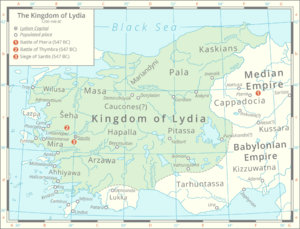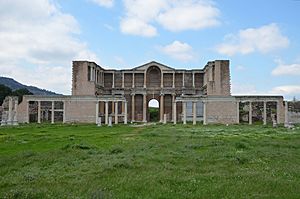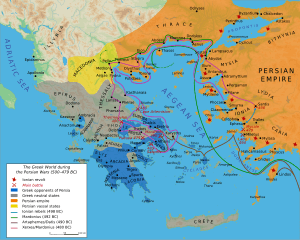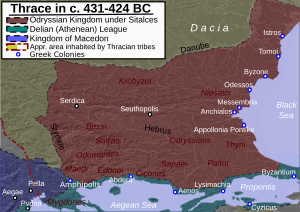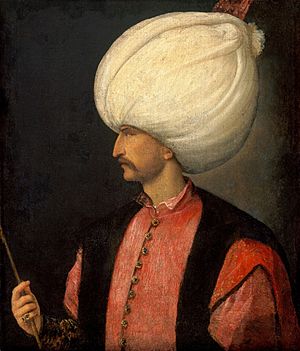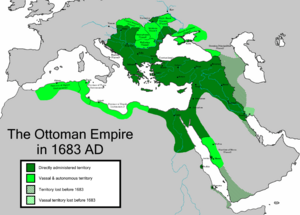History of Turkey facts for kids
The history of Turkey is the story of the land that makes up modern-day Turkey, including both Anatolia (the Asian part) and Eastern Thrace (the European part). These two areas, once separate, became part of the Roman Empire a long time ago, eventually forming the heart of the Byzantine Empire.
This history covers a long period, from when parts of Turkey were taken over by the Seljuq dynasty in the Middle Ages, through the powerful Ottoman Empire, and up to the history of the Republic of Turkey since the 1920s.
Contents
Ancient Times in Turkey
Humans have lived in Anatolia for a very, very long time, going back to the Paleolithic (Old Stone Age). We know this from tools and artifacts found across the region. Many of these ancient finds are now in museums in Turkey.
Göbekli Tepe is an amazing site with the oldest known human-made temple, built around 10,000 BC! Another important place is Çatalhöyük, a huge ancient village that existed from about 7500 BC to 5700 BC. It's one of the biggest and best-preserved Stone Age settlements ever found. The "Urfa Man" statue, from around 9000 BC, is the oldest known life-sized human sculpture. The city of Troy also started in the Stone Age and continued to be lived in for thousands of years.
As time went on, around 2500 BC, advanced civilizations began to appear in Anatolia during the Bronze Age. Groups like the Hattians, the Akkadian Empire, Assyria, and the Hittites built powerful empires. After the Hittites fell, new kingdoms like Phrygia and Lydia grew strong on the western coast.
Anatolia in Classical Times
After the Hittites, the lands of Anatolia were taken over by the powerful Persian Empire. The Persians divided Anatolia into different regions called "satrapies," each ruled by a governor called a "satrap." This system helped many port cities become rich through trade.
Anatolia was very important in Persian history. In the early 400s BC, some Greek cities in Anatolia, under Persian rule, rebelled. This led to the famous Greco-Persian Wars, which were very important for European history.
Persian rule in Anatolia ended when Alexander the Great conquered the region between 334 and 330 BC. After Alexander's death, his empire was split among his generals. Anatolia became part of the Seleucid Empire, which was the largest of Alexander's new kingdoms.
However, the Seleucids eventually fought a big war with the Roman Republic. After losing battles like Battle of Magnesia, they had to give up Anatolia in 188 BC. The Romans then gave these lands to their allies, the Kingdom of Pergamum and the Republic of Rhodes.
The Romans slowly gained more control over Anatolia. In the early 300s AD, Constantine the Great made a new main city at Constantinople (which was originally called Byzantium). By the end of the 300s, the Roman Empire split into two parts. The Eastern part, with Constantinople as its capital, is known today as the Byzantine Empire.
Thrace in Classical Times
The Thracians were ancient tribes who lived in a large area of Central and Southeastern Europe. They were neighbors with groups like the Scythians, Celts, and Greeks. They spoke their own language, called Thracian.
Around 1200 BC, the western coast of Anatolia was settled by Greek people. They founded many important cities like Miletus, Ephesus, and Byzantium (which later became Constantinople).
The Thracian lands were conquered by the Persian Empire in the late 500s BC. Later, the Thracians formed their own kingdom called the Odrysian kingdom. The ancient Greek historian Herodotus said the Thracians were the second most numerous people in the world he knew, after the Indians. However, they often lacked unity.
Before the rise of the Kingdom of Macedon, Thrace was divided. The Thracians usually lived in large villages rather than big cities.
The Byzantine Empire
The Persian Empire fell to Alexander the Great in 334 BC. This led to more Greek culture spreading in Anatolia. After Alexander died in 323 BC, Anatolia was divided into smaller Greek-style kingdoms. By the mid-1st century BC, all of these became part of the Roman Republic. Over time, the local languages and cultures in Anatolia disappeared, replaced mostly by ancient Greek language and culture.
In 324 AD, Constantine I chose Byzantium as the new capital of the Roman Empire, renaming it New Rome. After the death of Theodosius I in 395 AD, the Roman Empire permanently split. The city, which became known as Constantinople, became the capital of the Eastern Roman Empire. Historians later called this the Byzantine Empire. This empire ruled most of what is now Turkey until the Late Middle Ages.
The Byzantines and their neighbors, the Sassanid Persians, often fought over Anatolia. These wars made both empires weaker, which helped the Muslim armies from the south conquer parts of their lands later on.
The Byzantine Empire grew and shrank many times. During the rule of Justinian I (527-565 AD), the empire was at its largest since the fall of the Western Roman Empire. It took back many lands around the Mediterranean Sea, including Italy and Rome. However, a very long war with the Sassanids (602-628 AD) used up the empire's resources. In the 600s, it lost its richest provinces, Egypt and Syria, to the early Muslim conquests.
The fall of Constantinople to the Ottoman Empire in 1453 marked the end of the Byzantine Empire. Many people fleeing Constantinople after it was captured moved to Italy and other parts of Europe, helping to start the Renaissance.
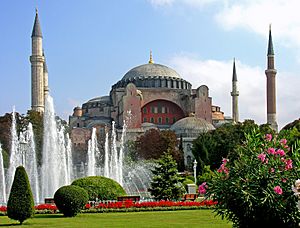
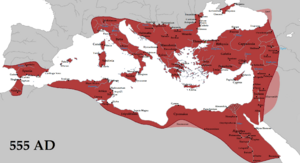
Early History of the Turks
Historians generally believe that the first Turkic people lived in a large area from Central Asia to Siberia. They appeared as a distinct group after the 6th century BC. The earliest separate Turkic groups were seen around the edges of the Xiongnu confederation about 200 BC.
Some scholars think the Xiongnu, mentioned in ancient Chinese records, might have been early Turkic speakers. The Hun armies of Attila, who invaded Europe in the 400s AD, might also have been Turkic.
In the 500s AD, the Göktürks became the leaders of the Turkic peoples. They united many nomadic Turkic tribes into the Göktürk Empire from 552 to 745 AD. The name "Göktürk" means "Celestial Turk." The Göktürks were the first Turkic people to write in a runic script, called the Orkhon script. Their empire was also the first state known as "Turk."
Over time, Turkic peoples and related groups moved west from Central Asia towards Eastern Europe, the Iranian plateau, and Anatolia (modern Turkey) in many waves. The main migration happened in medieval times, spreading across much of Asia, Europe, and the Middle East. They eventually established their own states, leading to the creation of the Ottoman Empire.
The Seljuk Empire
The Seljuk Turkmens created a powerful empire in the Middle Ages. It stretched from the Hindu Kush mountains to eastern Anatolia, and from Central Asia to the Persian Gulf. Starting from their homelands near the Aral Sea, the Seljuks first moved into Khorasan (a region in Central Asia) and then into Persia, before finally conquering eastern Anatolia.
The Seljuk Empire was founded by Tughril Beg in 1037. The Seljuks brought together the many divided states of the eastern Islamic world. They also played a key role in the Crusades. The Seljuks adopted much of Persian culture and language, and they helped spread Persian culture into Anatolia.
The Ottoman Empire
The Ottoman Empire began as a small state called a "beylik." Its first capital was in Bursa in 1326. Later, Edirne became the capital in 1361. The Ottomans grew very quickly, expanding into Europe and Anatolia.
In 1453, during the reign of Mehmed II, the Ottomans captured Constantinople, the capital of the Byzantine Empire. Constantinople then became the new capital of the Ottoman Empire. The empire continued to expand greatly in the 1400s, 1500s, and 1600s. It took over lands in Eastern Anatolia, Central Europe, the Caucasus, North and East Africa, islands in the Mediterranean, Syria, Mesopotamia, and the Arabian Peninsula.
The Ottoman Empire was at its strongest and most famous in the 1500s and 1600s, especially during the rule of Suleiman the Magnificent. The empire often fought with the Holy Roman Empire as it moved into Central Europe. It also had many wars with Persia over land. At sea, the Ottomans fought with European powers like Spain and Venice for control of the Mediterranean Sea. In the Indian Ocean, the Ottoman navy battled Portuguese fleets to protect their trade routes between East Asia and Western Europe.
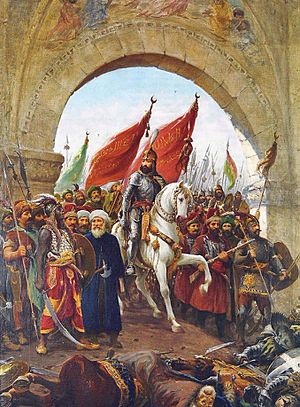
However, the Ottoman Empire began to shrink after the Treaty of Karlowitz in 1699. It lost many territories, including parts of Hungary, Greece, Algeria, Tunisia, Libya, and the Balkans. By the early 1900s, Anatolia was still home to many different groups of people, including Turks, Armenians, Assyrians, Kurds, Greeks, French, and Italians.
Facing many losses, the Ottoman Empire joined World War I (1914–1918) on the side of Germany and its allies. The empire was eventually defeated. After World War I, the huge Ottoman Empire was broken up into many new countries.
On October 30, 1918, a peace agreement called the Armistice of Mudros was signed. Then, on August 10, 1920, the Treaty of Sèvres was proposed by the Allied Powers. This treaty would have broken up the Ottoman Empire even more and given large parts of its land to Greece, Italy, Britain, and France. However, this treaty was never fully accepted.
The Republic of Turkey
The occupation of parts of the country by the Allied Powers after World War I led to the start of the Turkish national movement. Under the leadership of Mustafa Kemal, a military leader who was famous for his role in the Battle of Gallipoli, the Turkish War of Independence began. The goal was to reject the harsh terms of the Treaty of Sèvres.
By September 18, 1922, the armies occupying Turkey were driven out. On November 1, the newly formed Turkish parliament officially ended the Sultanate, which meant the end of 623 years of Ottoman rule. The Treaty of Lausanne, signed on July 24, 1923, officially recognized the new "Republic of Turkey" as the successor to the Ottoman Empire. The republic was officially announced on October 29, 1923, with its new capital in Ankara.
Mustafa Kemal became the first President of Turkey. He introduced many big changes, known as Atatürk's Reforms, to create a new, modern, and secular republic. For example, the traditional Ottoman fez hat was abolished, women gained full political rights, and a new writing system for Turkish, based on the Latin alphabet, was created. In 1934, the Turkish parliament gave Mustafa Kemal the special last name "Atatürk," meaning "Father of the Turks."
Turkey remained neutral during World War II (1939–1945). It signed a treaty with Britain in 1939, promising that Britain would defend Turkey if Germany attacked. Although an invasion was threatened in 1941, it never happened. Turkey continued to trade with both sides during the war. In February 1945, Turkey declared war on Germany and Japan, a symbolic move that allowed it to join the new United Nations.
After the war, relations with the Soviet Union became difficult, leading to the start of the Cold War. The Soviet Union wanted military bases in the Turkish Straits. This led the United States to announce the Truman Doctrine in 1947, promising to help Turkey and Greece. This resulted in a lot of military and economic support from the U.S.
After helping the United Nations forces in the Korean War, Turkey joined NATO in 1952. This made Turkey an important defense against Soviet expansion into the Mediterranean.
In 1974, after years of fighting between Greek and Turkish communities on the island of Cyprus, and a Greek military coup there, Turkey invaded the Republic of Cyprus. Nine years later, the Turkish Republic of Northern Cyprus (TRNC) was established. Turkey is the only country that recognizes the TRNC.
Turkey moved from a one-party system to a multi-party democracy after 1945. However, its democracy was interrupted by military takeovers in 1960, 1971, and 1980. In 1984, the Kurdistan Workers' Party (PKK) started a conflict against the Turkish government, which has continued and caused many lives to be lost. Since the 1980s, Turkey's economy has grown stronger, and its political situation has become more stable.
In August 2014, Recep Tayyip Erdoğan became Turkey's first directly elected president. In July 2016, there was an attempted coup by some parts of the military, but it was stopped after a few hours.
In April 2017, a public vote approved changes to the constitution that greatly increased the powers of the Turkish President. In June 2018, President Erdoğan was re-elected for a new five-year term.
In July 2022, the Turkish government asked the international community to use its Turkish name, Türkiye, partly because the English word "Turkey" is also the name of a bird.
In May 2023, President Erdoğan won another re-election, and his AK Party and its allies kept their majority in parliament.
See also
 In Spanish: Historia de Turquía para niños
In Spanish: Historia de Turquía para niños
|



